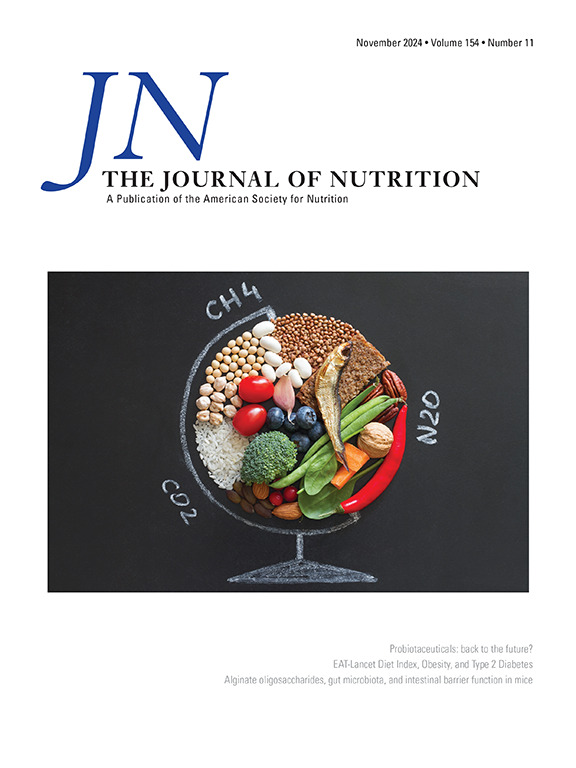Assuming the “Best-Fit” Shape of the Usual Nutrient Intake Distribution (with nutriR) Does Not Affect Prevalence Estimates of Nutrient Intake Inadequacy: Results from a Dietary Intake Survey in Ivorian School-Age Children
IF 3.8
3区 医学
Q2 NUTRITION & DIETETICS
引用次数: 0
Abstract
Background
Common methods to assess nutrient intake inadequacy are the estimated average requirement (EAR) cut-point method and the probability of adequacy (PA). It has been postulated that the shape of the intake distribution can have a significant impact on estimates of inadequacy. The “nutritional intake functions for R” (“nutriR”) package has been developed to address this.
Objectives
This study aimed to assess the impact of assuming the “best-fit” shape of nutrient intake distributions (using nutriR) on prevalence estimates of inadequate nutrient intake, as compared with observed nutrient intake distributions with the EAR cut-point or PA method.
Methods
A cross-sectional dietary intake survey was conducted among 443 Ivorian school-aged children (6–12 y) by 24-h recall, with nonconsecutive repeats for 13% of the population. Six methods to estimate the prevalence of intake inadequacy for 11 nutrients were compared: methods 1–3 used single 24-h recall data to either apply the 1) EAR cut-point method, 2) the PA method, or 3) the nutriR method; and methods 4–6 applied the same methods after correction for within-person variation using the Statistical Program to Assess Usual Dietary Exposure, which generates estimates of usual daily nutrient intake.
Results
Nutrient intake distributions were right skewed (skewness average 1.0, range: 0.4–2.0) and showed large variation (coefficient of variation average 40%, range: 20%–60%). The prevalence estimates of inadequate nutrient intake were similar across all methods, with a mean difference of ±5 percent point (range: 0–27 percent point). The smallest mean differences, 0.4 and 0.3 percent points, were observed with usual intake data between nutriR and EAR cut-point (method 6 compared with 4), and nutriR and PA (method 6 compared with 5), respectively. Larger differences (∼12 percent point) were observed when comparing single 24-h recall data (methods 1–3) with usual intake (methods 4–6).
Conclusions
Assuming nutrient intake distributions with the shape of “best-fit” to the observed intake distribution did not affect prevalence estimates of nutrient inadequacy in this population of Ivorian school children.
This study was registered at clinicaltrials.gov as NCT06175130.
假设通常的营养摄入分布的“最合适”形状(含营养因子)并不影响营养摄入不足的患病率估计:来自科特迪瓦学龄儿童膳食摄入调查的结果。
背景:评估营养摄入不足的常用方法是EAR切点法和充足概率法(PA)。据推测,摄入分布的形状可以对不足的估计产生重大影响。“R的营养摄入功能”(“nutriR”)包装就是为了解决这个问题而开发的。目的:与EAR切点法或PA法观察到的营养摄入分布相比,评估假设营养摄入分布的“最佳拟合”形状(使用nutriR)对营养摄入不足患病率估计的影响。方法:采用24小时回顾法对443名科特迪瓦学龄儿童(6-12岁)进行横断面饮食摄入调查,其中13%为非连续重复调查。比较了六种估计11种营养素摄入不足患病率的方法:方法1-3使用单一24小时回忆数据,应用EAR切入点法(1)、PA法(2)或营养系数法(3);方法4-6在使用通常饮食暴露评估统计程序(SPADE)对个人内部差异进行校正后应用了相同的方法,该程序产生通常每日营养摄入量的估计值。结果:营养摄入分布呈右偏态(偏度平均值为1.0,范围为0.4 ~ 2.0),变异较大(变异系数平均值为40%,范围为20 ~ 60%)。所有方法对营养摄入不足的患病率估计相似,平均差异为±5个百分点(范围:0-27个百分点)。在常规摄入数据中,nutriR和EAR临界值(方法6 vs .4)以及nutriR和PA(方法6 vs . 5)之间的平均差异最小,分别为0.4和0.3个百分点。当比较单一24小时回忆数据(方法1-3)与常规摄入量(方法4-6)时,观察到较大的差异(~ 12个百分点)。结论:假设营养摄入分布的形状与观察到的摄入分布“最吻合”,并不影响科特迪瓦学龄儿童营养不足的患病率估计。临床试验注册编号及获取网站:NCT06175130 www.Clinicaltrials: gov。
本文章由计算机程序翻译,如有差异,请以英文原文为准。
求助全文
约1分钟内获得全文
求助全文
来源期刊

Journal of Nutrition
医学-营养学
CiteScore
7.60
自引率
4.80%
发文量
260
审稿时长
39 days
期刊介绍:
The Journal of Nutrition (JN/J Nutr) publishes peer-reviewed original research papers covering all aspects of experimental nutrition in humans and other animal species; special articles such as reviews and biographies of prominent nutrition scientists; and issues, opinions, and commentaries on controversial issues in nutrition. Supplements are frequently published to provide extended discussion of topics of special interest.
 求助内容:
求助内容: 应助结果提醒方式:
应助结果提醒方式:


